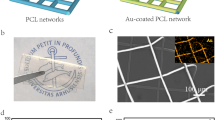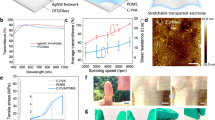Abstract
The flexible organic phototransistors (OPTs) are crucial for next-generation wearable systems for applications where large mechanical deformation is involved. However, most of the reported OPTs utilizing the field-effect transistor (FET) architecture suffer from undesired mechanical flexibility and limited performance due to their interfacial charge transport and inherently low transconductance; moreover, their π-conjugated semiconductor polymers that serve as channels lack specific healing sites, making it difficult to intrinsically heal themselves. Herein, a more flexible and high-performance OPT with enhanced interfacial charge transport via novel volumetric channel and strong healing capability is developed for the first time. This OPT utilizes an organic electrochemical transistor architecture that consists of intrinsically healing conducting polymer/hydrogel composite films with three-dimensional volumetric channels. Such devices not only efficiently restore their mechanical and electrical performance in 100 ms after undergoing severe damage but also exhibit excellent mechanical flexibility without obviously degraded performance. More importantly, the self-healing OPTs exhibit high performance with a responsivity as high as 1.01 × 105 A W−1, detectivity of 1.75 × 1012 Jones, and high external quantum efficiency of 3.03 × 104%, higher than those of the majority of the reported FET-based OPTs. All of these results indicate that these novel and intrinsically self-healing OPTs with volumetric channels are ideal for use in next-generation wearable devices.

摘要
柔性有机光电晶体管(OPTs)在大机械形变的下一代可穿戴系统 中至关重要. 然而, 目前报道的大多数OPTs都是场效应基结构, 其界面 电荷传输和本征低跨导的特性限制了OPTs的机械柔性和光电性能的 发展. 此外, 沟道层的p共轭半导体聚合物也缺乏特殊的可修复位点, 使 其很难实现薄膜的自我修复功能. 本文报道了一个具有独特体沟道和 **修复功能的柔性高光电性能的OPTs. 该OPTs使用有机电化学晶体 管架构, 由3D体沟道的可修复导电聚合物/水凝胶复合薄膜组成. 该器 件不仅在遭受损伤后能够在100 ms内有效恢复其机械和电学性能, 同 时还展现出出色的机械柔性. 更重要的是, 该器件实现了紫外光波段的 高光测性能, 其中光响应度高达1.01 × 105 A W−1, 探测率达 1.01 × 105 A W−1, 外量子效率达3.03 × 104%. 结果表明, 具有独特体沟 道和本征可修复功能的OPTs在下一代可穿戴电子器件的使用中具有 潜在应用价值.
Similar content being viewed by others
References
An C, Nie F, Zhang R, et al. Two-dimensional material-enhanced flexible and self-healable photodetector for large-area photodetection. Adv Funct Mater, 2021, 31: 2100136
Lee YH, Park S, Won Y, et al. Flexible high-performance graphene hybrid photodetectors functionalized with gold nanostars and perovskites. NPG Asia Mater, 2020, 12: 79
Zhang Y, Qiu Y, Li X, et al. Organic single-crystalline microwire arrays toward high-performance flexible near-infrared phototransistors. Small, 2022, 18: e2203429
Chow PCY, Someya T. Organic photodetectors for next-generation wearable electronics. Adv Mater, 2020, 32: 1902045
Ahn S, Chen W, Moreno-Gonzalez MA, et al. Enhanced charge transfer and responsivity in hybrid quantum dot/graphene photodetectors using ZnO as intermediate electron-collecting layer. Adv Elect Mater, 2020, 6: 2000014
Chang YH, Ku CW, Zhang YH, et al. Ultrafast responsive non-volatile flash photomemory via spatially addressable perovskite/block copolymer composite film. Adv Funct Mater, 2020, 30: 2000764
Guo J, Jiang S, Pei M, et al. Few-layer organic crystalline van der Waals heterojunctions for ultrafast UV phototransistors. Adv Elect Mater, 2020, 6: 2000062
Zou C, ** Y, Huang C, et al. A highly sensitive UV-vis-NIR all-inorganic perovskite quantum dot phototransistor based on a layered heterojunction. Adv Opt Mater, 2018, 6: 1800324
Simone G, Dyson MJ, Meskers SCJ, et al. Organic photodetectors and their application in large area and flexible image sensors: The role of dark current. Adv Funct Mater, 2020, 30: 1904205
Zhao Z, Xu C, Niu L, et al. Recent progress on broadband organic photodetectors and their applications. Laser & Photonics Rev, 2020, 14: 2000262
Calvi S, Rapisarda M, Valletta A, et al. Highly sensitive organic phototransistor for flexible optical detector arrays. Org Electron, 2022, 102: 106452
Huang X, Liu Y, Liu G, et al. Short-wave infrared synaptic phototransistor with ambient light adaptability for flexible artificial night visual system. Adv Funct Mater, 2023, 33: 2208836
Kim JH, Stolte M, Würthner F. Wavelength and polarization sensitive synaptic phototransistor based on organic n-type semiconductor/supramolecular J-aggregate heterostructure. ACS Nano, 2022, 16: 19523–19532
Wang M, Sun H, Cao F, et al. Moisture-triggered self-healing flexible perovskite photodetectors with excellent mechanical stability. Adv Mater, 2021, 33: 2100625
Cai S, Xu X, Yang W, et al. Materials and designs for wearable photodetectors. Adv Mater, 2019, 31: 1808138
Gu P, Yao Y, Feng L, et al. Recent advances in polymer phototransistors. Polym Chem, 2015, 6: 7933–7944
Huang X, Ji D, Fuchs H, et al. Recent progress in organic phototransistors: semiconductor materials, device structures and optoelectronic applications. ChemPhotoChem, 2019, 4: 9–38
Yan Y, Yu R, Gao C, et al. High-performance n-type thin-film transistor based on bilayer MXene/semiconductor with enhanced electrons transport. Sci China Mater, 2022, 65: 3087–3095
Di C, Liu Y, Yu G, et al. Interface engineering: An effective approach toward high-performance organic field-effect transistors. Acc Chem Res, 2009, 42: 1573–1583
Rivnay J, Inal S, Salleo A, et al. Organic electrochemical transistors. Nat Rev Mater, 2018, 3: 17086
Sun H, Gerasimov J, Berggren M, et al. n-Type organic electrochemical transistors: Materials and challenges. J Mater Chem C, 2018, 6: 11778–11784
Friedlein JT, McLeod RR, Rivnay J. Device physics of organic electrochemical transistors. Org Electron, 2018, 63: 398–414
Massetti M, Zhang S, Harikesh PC, et al. Fully 3D-printed organic electrochemical transistors. Npj Flex Electron, 2023, 7: 11
Koutsouras DA, Torricelli F, Blom PWM. Submicron vertical channel organic electrochemical transistors with ultrahigh transconductance. Adv Elect Mater, 2023, 9: 2200868
Rivnay J, Leleux P, Sessolo M, et al. Organic electrochemical transistors with maximum transconductance at zero gate bias. Adv Mater, 2013, 25: 7010–7014
Tan STM, Giovannitti A, Melianas A, et al. High-gain chemically gated organic electrochemical transistor. Adv Funct Mater, 2021, 31: 2010868
Montero-Jimenez M, Amante FL, Fenoy GE, et al. PEDOT-polyamine-based organic electrochemical transistors for monitoring protein binding. Biosensors, 2023, 13: 288
Huang W, Chen J, Yao Y, et al. Vertical organic electrochemical transistors for complementary circuits. Nature, 2023, 613: 496–502
Fu Y, Wang N, Yang A, et al. Highly sensitive detection of protein biomarkers with organic electrochemical transistors. Adv Mater, 2017, 29: 1703787
Venkatraman V, Friedlein JT, Giovannitti A, et al. Subthreshold operation of organic electrochemical transistors for biosignal amplification. Adv Sci, 2018, 5: 1800453
Wang C, Wu H, Chen Z, et al. Self-healing chemistry enables the stable operation of silicon microparticle anodes for high-energy lithium-ion batteries. Nat Chem, 2013, 5: 1042–1048
Chortos A, Liu J, Bao Z. Pursuing prosthetic electronic skin. Nat Mater, 2016, 15: 937–950
Guan Q, Lin G, Gong Y, et al. Highly efficient self-healable and dual responsive hydrogel-based deformable triboelectric nanogenerators for wearable electronics. J Mater Chem A, 2019, 7: 13948–13955
Kee S, Haque MA, Corzo D, et al. Self-healing and stretchable 3D-printed organic thermoelectrics. Adv Funct Mater, 2019, 29: 1905426
Ko J, Surendran A, Febriansyah B, et al. Self-healable electrochromic ion gels for low power and robust displays. Org Electron, 2019, 71: 199–205
Kwon S, Kim J, Kim G, et al. Organic single-crystal semiconductor films on a millimeter domain scale. Adv Mater, 2015, 27: 6870–6877
Lv Z, Zhou Y, Han ST, et al. From biomaterial-based data storage to bio-inspired artificial synapse. Mater Today, 2018, 21: 537–552
Baeg KJ, Binda M, Natali D, et al. Organic light detectors: Photodiodes and phototransistors. Adv Mater, 2013, 25: 4267–4295
Bai S, Yang L, Haase K, et al. Nanographene-based heterojunctions for high-performance organic phototransistor memory devices. Adv Sci, 2023, 10: 2300057
Shin H, Kim D, Park J, et al. Improving photosensitivity and transparency in organic phototransistor with blending insulating polymers. Micromachines, 2023, 14: 620
Qiu LZ, Wei SY, Xu HS, et al. Ultrathin polymer nanofibrils for solarblind deep ultraviolet light photodetectors application. Nano Lett, 2020, 20: 644–651
Li B, Zhang Y, Liu Y, et al. Highly efficient contact do** for high-performance organic UV-sensitive phototransistors. Crystals, 2022, 12: 651
Lou Y, Shi R, Yu L, et al. A new dithieno[3,2-b:2′,3′-d]thiophene derivative for high performance single crystal organic field-effect transistors and UV-sensitive phototransistors. RSC Adv, 2023, 13: 11706–11711
Li D, Jia Z, Tang Y, et al. Inorganic-organic hybrid phototransistor array with enhanced photogating effect for dynamic near-infrared light sensing and image preprocessing. Nano Lett, 2022, 22: 5434–5442
Romele P, Ghittorelli M, Kovács-Vajna ZM, et al. Ion buffering and interface charge enable high performance electronics with organic electrochemical transistors. Nat Commun, 2019, 10: 3044
Rivnay J, Inal S, Collins BA, et al. Structural control of mixed ionic and electronic transport in conducting polymers. Nat Commun, 2016, 7: 11287
Groenendaal L, Jonas F, Freitag D, et al. Poly(3,4-ethylenediox-ythiophene) and its derivatives: Past, present, and future. Adv Mater, 2000, 12: 481–494
Dupont SR, Novoa F, Voroshazi E, et al. Decohesion kinetics of PEDOT:PSS conducting polymer films. Adv Funct Mater, 2014, 24: 1325–1332
Xu C, Nie J, Wu W, et al. Design of self-healable supramolecular hybrid network based on carboxylated styrene butadiene rubber and nanochitosan. Carbohydrate Polyms, 2019, 205: 410–419
Cao Y, Tan YJ, Li S, et al. Self-healing electronic skins for aquatic environments. Nat Electron, 2019, 2: 75–82
**a S, Song S, Jia F, et al. A flexible, adhesive and self-healable hydrogel-based wearable strain sensor for human motion and physiological signal monitoring. J Mater Chem B, 2019, 7: 4638–4648
Acknowledgements
The work was supported by the National Natural Science Foundation of China (62304189 and 62304002), the Natural Science Foundation of **amen City (3502Z20227063), the Natural Science Foundation of Fujian Province (2023J011450 and 2023J011452), the Key Technologies Innovation and Industrialization Projects of Fujian Province (2023XQ022), the National Natural Science Foundation of China Joint Fund for Cross-strait Scientific and Technological Cooperation (U2005212), and the Open Fund of **amen Key Laboratory of High Performance Metal and Materials of **amen University.
Author information
Authors and Affiliations
Contributions
Author contributions Chen H and **e A conceived the project. Yan Y, Zhu X, Zhang G, and Wang X designed and performed the experiments and collected the data. Yan Y, Zhu X, Li W, Sun D, Li Y, and Han X analyzed and discusssed the data. Yan Y, Zhu X, Chen H, and **e A wrote and reviewed the paper. All authors contributed to the general discussion.. All authors have read and agreed to the published version of the manuscript.
Corresponding authors
Ethics declarations
Conflict of interest The authors declare that they have no conflict of interest.
Additional information
Supplementary information Supporting data are available in the online version of the paper.
Yujie Yan is now an associate professor at the School of Materials Science and Engineering, **amen University of Technology. He received his PhD degree from Fuzhou University in 2021. His research interest focuses on nanoscale optoelectronic devices including transistors, photodetectors, and electrochromic devices.
An **e is a full professor at the Department of Materials Science and Engineering, **amen University of Technology. He received his PhD degree from the Department of Rock and Mineral Material Science, China University Of Geosciences, Wuhan, in 2010. He worked as a deputy chief engineer and postdoctor at Fushun Optoelectronics Technology Limited Company. His research is focusing on the optoelectronic films and display materials.
Huipeng Chen got his PhD degree from Tufts University in 2009. Before joining the College of Physics and Information Engineering, Fuzhou University in 2015, he worked as a postdoctoral fellow at Texas Tech University during 2009–2011 and the University of Tennessee and Oak Ridge National Laboratory from 2011 to 2014. His research interest is the research of semiconductor materials and devices, including thin film transistors, memories, sensors, and neuromorphic electronic devices and systems.
Electronic supplementary material
40843_2023_2794_MOESM1_ESM.pdf
Intrinsically healing conducting polymer/hydrogel nanocomposite films and their novel volumetric channel for high-performance, flexible, and healable organic phototransistors
Rights and permissions
About this article
Cite this article
Yan, Y., Zhu, X., Zhang, G. et al. Intrinsically healing conducting polymer/hydrogel nanocomposite films and their novel volumetric channel for high-performance, flexible, and healable organic phototransistors. Sci. China Mater. 67, 1491–1499 (2024). https://doi.org/10.1007/s40843-023-2794-7
Received:
Accepted:
Published:
Issue Date:
DOI: https://doi.org/10.1007/s40843-023-2794-7




